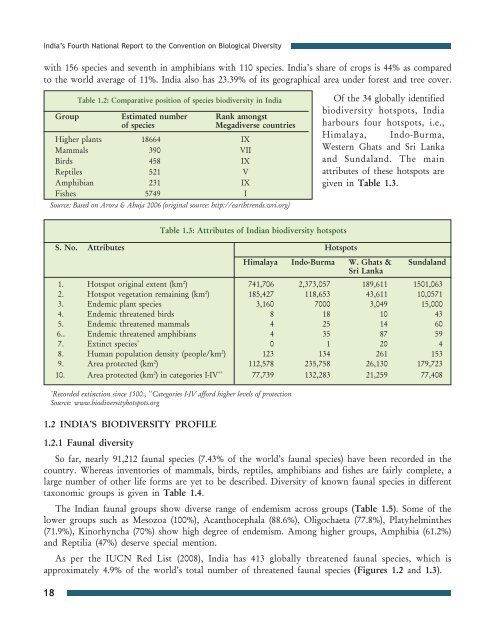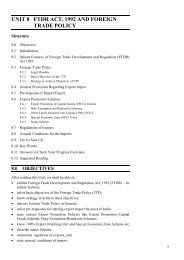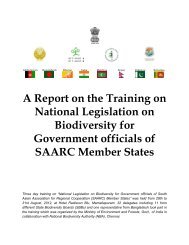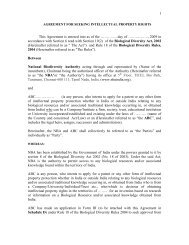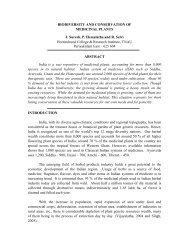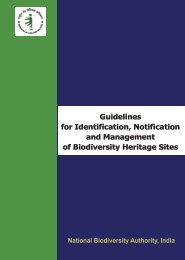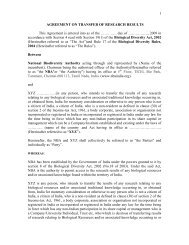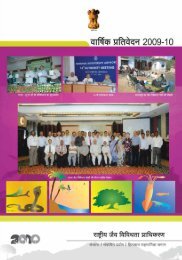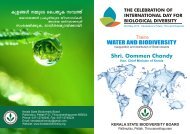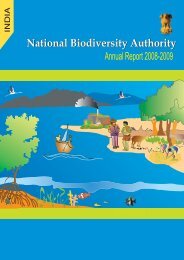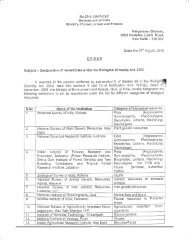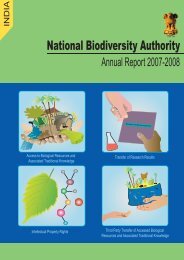Part 1 - English version (PDF) - Convention on Biological Diversity
Part 1 - English version (PDF) - Convention on Biological Diversity
Part 1 - English version (PDF) - Convention on Biological Diversity
Create successful ePaper yourself
Turn your PDF publications into a flip-book with our unique Google optimized e-Paper software.
India’s Fourth Nati<strong>on</strong>al Report to the <str<strong>on</strong>g>C<strong>on</strong>venti<strong>on</strong></str<strong>on</strong>g> <strong>on</strong> <strong>Biological</strong> <strong>Diversity</strong><br />
with 156 species and seventh in amphibians with 110 species. India’s share of crops is 44% as compared<br />
to the world average of 11%. India also has 23.39% of its geographical area under forest and tree cover.<br />
Table 1.2: Comparative positi<strong>on</strong> of species biodiversity in India<br />
Group Estimated number Rank am<strong>on</strong>gst<br />
of species<br />
Megadiverse countries<br />
Higher plants 18664 IX<br />
Mammals 390 VII<br />
Birds 458 IX<br />
Reptiles 521 V<br />
Amphibian 231 IX<br />
Fishes 5749 I<br />
Source: Based <strong>on</strong> Arora & Ahuja 2006 (original source: http://earthtrends.wri.org)<br />
Of the 34 globally identified<br />
biodiversity hotspots, India<br />
harbours four hotspots, i.e.,<br />
Himalaya, Indo-Burma,<br />
Western Ghats and Sri Lanka<br />
and Sundaland. The main<br />
attributes of these hotspots are<br />
given in Table 1.3.<br />
18<br />
Table 1.3: Attributes of Indian biodiversity hotspots<br />
S. No. Attributes Hotspots<br />
Himalaya Indo-Burma W. Ghats & Sundaland<br />
Sri Lanka<br />
1. Hotspot original extent (km 2 ) 741,706 2,373,057 189,611 1501,063<br />
2. Hotspot vegetati<strong>on</strong> remaining (km 2 ) 185,427 118,653 43,611 10,0571<br />
3. Endemic plant species 3,160 7000 3,049 15,000<br />
4. Endemic threatened birds 8 18 10 43<br />
5. Endemic threatened mammals 4 25 14 60<br />
6.. Endemic threatened amphibians 4 35 87 59<br />
7. Extinct species * 0 1 20 4<br />
8. Human populati<strong>on</strong> density (people/km 2 ) 123 134 261 153<br />
9. Area protected (km 2 ) 112,578 235,758 26,130 179,723<br />
10. Area protected (km 2 ) in categories I-IV ** 77,739 132,283 21,259 77,408<br />
*<br />
Recorded extincti<strong>on</strong> since 1500., ** Categories I-IV afford higher levels of protecti<strong>on</strong><br />
Source: www.biodiversityhotspots.org<br />
1.2 INDIA’S BIODIVERSITY PROFILE<br />
1.2.1 Faunal diversity<br />
So far, nearly 91,212 faunal species (7.43% of the world’s faunal species) have been recorded in the<br />
country. Whereas inventories of mammals, birds, reptiles, amphibians and fishes are fairly complete, a<br />
large number of other life forms are yet to be described. <strong>Diversity</strong> of known faunal species in different<br />
tax<strong>on</strong>omic groups is given in Table 1.4.<br />
The Indian faunal groups show diverse range of endemism across groups (Table 1.5). Some of the<br />
lower groups such as Mesozoa (100%), Acanthocephala (88.6%), Oligochaeta (77.8%), Platyhelminthes<br />
(71.9%), Kinorhyncha (70%) show high degree of endemism. Am<strong>on</strong>g higher groups, Amphibia (61.2%)<br />
and Reptilia (47%) deserve special menti<strong>on</strong>.<br />
As per the IUCN Red List (2008), India has 413 globally threatened faunal species, which is<br />
approximately 4.9% of the world’s total number of threatened faunal species (Figures 1.2 and 1.3).


